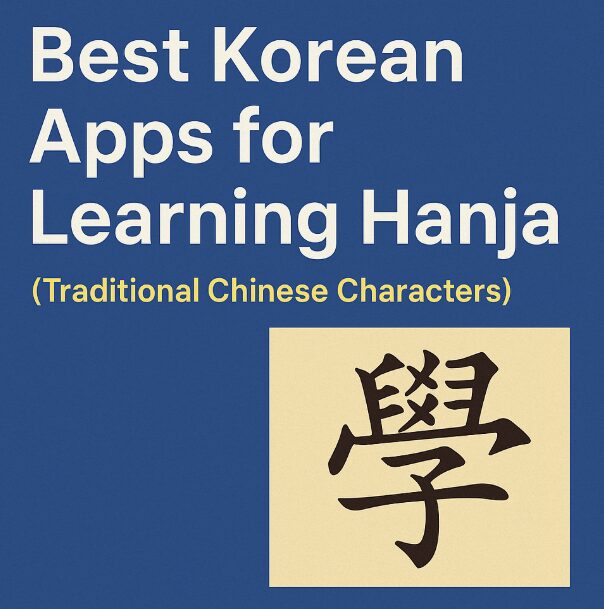For many language learners, Korean is already a complex challenge with its unique grammar structure and vocabulary. But there’s another layer often overlooked: Hanja (한자), the Korean name for Chinese characters. Although Hangul is the main script in modern Korean, Hanja still plays a significant role in education, academic texts, legal documents, newspapers, and even personal names.
If you’re a Chinese or Japanese speaker, learning Hanja can be an interesting shortcut to understanding Korean etymology, vocabulary nuances, and even unlocking hanja-based idioms (사자성어). Conversely, if you’re a Korean learner curious about deeper linguistic roots or preparing for Hanja Proficiency Exams (한자능력검정시험), using mobile apps can make your study process easier and more effective.
In this post, we’ll explore the best Korean apps for learning Hanja, with an emphasis on tools that are effective for foreign users, including speakers of Chinese, Japanese, and English.

Why Learn Hanja as a Korean Language Learner?
Hanja refers to traditional Chinese characters used in Korean. While Hangul is the standard script today, many Korean words still derive from Hanja roots — especially compound nouns, academic vocabulary, and legal or bureaucratic language.
Reasons to study Hanja:
Understand word origins and disambiguate homonyms
Improve vocabulary retention and guessing unfamiliar words
Access newspapers, classical literature, and formal writing
Pass Hanja Proficiency Tests (often required in government/legal sectors)
Understand Korean names and historical texts
Gain cross-linguistic insight if you speak Japanese or Chinese
What to Look for in a Hanja Learning App
The best Hanja apps should include:
A structured level system (e.g., based on Korean Hanja exam levels or school curriculum)
Stroke order animations and writing practice
Flashcard-based review and spaced repetition
Word examples with Hangul + Hanja + English
Quiz modes, audio, and custom decks
(Bonus) Chinese and Japanese translation support
Many Hanja apps are developed in Korea and only available in Korean, but some also support English or have intuitive design that makes them accessible even without language fluency.
Top Korean Apps for Learning Hanja (2025 Update)
1. 네이버 한자사전 (Naver Hanja Dictionary)
Platform: iOS / Android / Web
Language: Korean (interface), English available in some definitions
Best for: Reference, word lookups, example usage
Naver’s Hanja dictionary is part of its broader suite of language tools and offers:
Radical and stroke-based character search
Example words using Hanja with Hangul + English
Cross-search with Korean-Chinese dictionary
Name-specific Hanja lookup (great for decoding Korean names)
Although not a learning app per se, it’s an essential reference for any Hanja learner.
2. 한자능력시험 – 급수별 한자암기
Platform: Android only
Language: Korean only
Best for: Preparing for the Hanja Proficiency Test (한자능력검정시험)
This app categorizes characters by 시험 급수 (exam level) — from 초급 to 고급. Each level has:
Flashcards with stroke order and meaning
Hangul pronunciation and example vocabulary
Quizzes to test recall
Favorites and tracking features
Great for intermediate or advanced learners. The interface is clean, even without English support.
3. Hanja Time (한자 타임)
Platform: iOS only
Language: Korean and English
Best for: Beginners who want simple daily practice
Hanja Time is designed for people who want to study just a few characters each day. Features include:
Flashcards with English, Hangul, and Hanja
Stroke order animations
Daily review reminders
Example usage and idioms
It’s beginner-friendly and helpful for casual learners or K-culture fans curious about Hanja meanings.
4. Pleco (with Korean Hanja add-on)
Platform: iOS / Android
Language: English, Chinese
Best for: Chinese speakers learning Hanja
While Pleco is a Chinese learning app, it supports Korean Hanja with add-on dictionaries. You can:
Search a Chinese character and see Korean Hanja meanings
Compare pronunciation in Mandarin and Korean
View character decomposition and example sentences
Create custom flashcard decks
Ideal for Chinese speakers or advanced Korean learners with a Hanzi background.
5. 수박씨닷컴 한자급수 (Subakssi Hanja)
Platform: Web-based / Android
Language: Korean
Best for: Kids, teenagers, or visual learners
Subakssi offers structured Hanja learning based on school-level curriculums. It uses:
Animated lectures (cartoon-style)
Level-by-level practice
Fun quizzes and gamified content
Stroke practice sheets (PDFs)
Though intended for Korean students, it’s surprisingly useful for foreign learners with visual learning preferences.
🔗 Website: https://www.soobakc.com
6. 한자 따라 쓰기 – 한자 쓰기 연습
Platform: Android
Language: Korean
Best for: Stroke order and handwriting practice
This app is focused purely on writing. It shows:
Animated stroke orders
Grid writing guides
Practice mode with finger tracing
Levels based on exam grade levels
Good if your goal is to read AND write Hanja fluently.
Bonus Tools for Japanese or Chinese Speakers
If you already read Kanji or Hanzi, consider:
Google Translate handwriting input to compare character forms
Kanji Study (Android/iOS) — includes Korean pronunciation for some characters
Jukugo or 四字熟語 apps — many Korean 사자성어 idioms are shared with Japanese yojijukugo
These tools won’t replace dedicated Hanja apps but are helpful for comparing across languages.
Tips for Learning Hanja Effectively
Don’t memorize characters in isolation. Learn them with compound words or idioms.
Study characters in context, especially with native Korean vocabulary.
Use spaced repetition systems (Anki, Memrise) to reinforce memory.
Practice writing and reading aloud for deeper recall.
Pair Hanja with Korean vocabulary apps like TOPIK One or Duolingo for general review.
Hanja Might Be Optional — But It’s a Powerful Advantage
While modern Korean doesn’t require fluency in Hanja, knowing it gives you an edge — especially in academic, legal, literary, or traditional contexts. For Japanese and Chinese speakers, learning Hanja can deepen your understanding of Korean faster and more accurately. And for English speakers, it opens the door to Korean history, culture, and etymology that Hangul alone doesn’t fully reveal.
By using apps like Hanja Time, Naver Dictionary, or Subakssi, you can start small — even one character a day — and build your skills over time. As you progress, you’ll not only read Korean with more clarity but also develop a deep appreciation for how its language evolved alongside Chinese and Japanese.